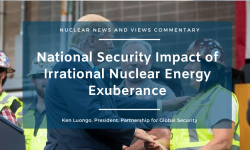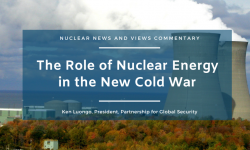Seven years ago, the Partnership for Global Security and the Nuclear Energy Institute launched the Global Nexus Initiative as a first-of-its kind experiment in whether non-traditional partners could effectively collaborate at the intersection of nuclear energy, climate change, and global security. It gathered numerous international experts from diverse disciplines to work through these issues.
Last month at COP 27 in Egypt, an event that gathered more than 100 Heads of State and Governments and had over 35,000 participants, the Global Nexus Agenda was squarely at the center of the international mainstream.
A leading manifestation of the rising role of nuclear energy as a climate response was the first ever nuclear-related pavilion at a COP, the IAEA’s #Atoms4Climate venue. The pavilion was host to over 40 events on the intersection of nuclear technology and carbon reduction.
At its launching, the IAEA’s Director General stated that it is “a reflection of how things are changing…[and that] Nuclear is already part of the solution, and nuclear will continue to be on this path.”
Just a few years ago, the IAEA DG made the first Agency speech at a COP in Madrid, despite being cautioned against it because of prejudices against the role of nuclear power in responding to climate change.
Now circumstances have changed. The nuclear energy community had its largest presence ever at COP 27 and additional nuclear companies joined the U.N.’s 24/7 Carbon-free Energy Compact. The signatories now include NuScale, TerraPower, Terrestrial Energy, Westinghouse, Nuclearelectrica, Constellation Energy Corporation, Energy Harbor, Xcel Energy, and NEI.
The U.S. government at COP 27 also was active in supporting nuclear energy as a climate response, with the U.S. Special Envoy for Climate announcing an SMR demonstration in Ukraine and advances in nuclear power development in Romania.
The U.S. Energy Secretary stated that, “People understand atoms now as being a really important piece of the clean energy future.”
However, not only has nuclear power been accepted as a climate response it has moved beyond that zero-carbon value and is being embraced as a pathway toward energy security and away from fossil fuel dependence on Russia and unstable suppliers.
A high-profile manifestation of this is the U.K. government’s decision to take an $840 million stake in the construction of the new Sizewell C nuclear plant. That deal paid off China General Nuclear and eliminated it as a 20% partner in the plant’s financing.
The decision is part of Britain’s move away from China as a sensitive technology partner, with the Prime Minister noting that the “golden era” of relations with China was over and had been “naïve.” He further noted that China was moving toward even greater authoritarianism and therefore “poses a systemic challenge to our values and interests.”
Outside of the developed world, there are significant clean energy needs. As the Breakthrough Institute has noted, sub-Saharan Africa uses the same amount of electricity as Spain, but has 18 times its population. Most African countries are highly dependent on fossil fuels or hydro power that is being impacted by climate change.
They, and many other developing nations, suffer from significant energy poverty. There is great possibility for nuclear energy in Africa, with Ghana a key target for SMR deployment.
Of course, the competition from Russia and China for that developing economy market continues.
China is already well ahead of all western nations in cultivating the developing world through the Belt and Road Initiative. And despite its raging conflict in Ukraine and the wanton destruction of energy infrastructure as a weapon of war, just last week Russia signed about 50 agreements on nuclear energy primarily with African entities.
There now is significant government and private sector financing pouring into the future of nuclear energy. This means that the U.S. and its allies need to sharpen their outdated strategy for developing the smaller nuclear markets of the future and updating their models for joint collaboration. It also means that they need to move faster to develop the nuclear security and governance regime that will be required for the deployment of these next-generation technologies.
The elevation of the Nexus Agenda as a global priority is a remarkable development. It underscores the dramatic transformation in the international energy, security, and climate landscape over just a few years. Its value is based on the new reality that the intersection of nuclear energy, climate change, and global security is necessary to meet the seriousness of the moment. Delivering on the promise is essential.
Ken Luongo, President, Partnership for Global Security





